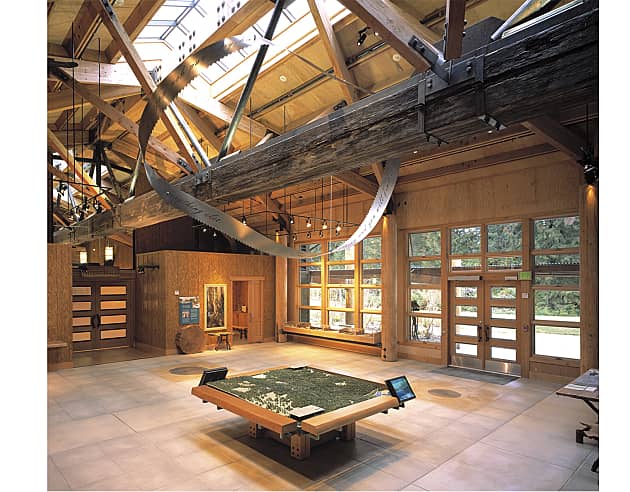- Project uploaded by Canadian Wood Council on 03-26-2023
- Project last updated by Canadian Wood Council on 04-21-2023
McEwen School of Architecture
Greater Sudbury, ONThe first new Canadian school of architecture to open in 40 years, the school is a teaching laboratory for the advancement of sustainable and resilient design for northern climates. Located in the heart of the Canadian Shield about 400 kilometers north of Toronto, the school draws on the architectural traditions of the English, French and Aboriginal communities of Northern Ontario. Its goal is to encourage students to learn not only from the faculty, but also from each other. The project to renovate two century-old buildings (totaling 1,830 square metres) and add a new 4,845 square metre building is intended to showcase wood, steel and masonry construction, highlighting the structural potential and aesthetic qualities of each of the materials, while illustrating the value and importance of their adaptive re-use. The two renovated heritage buildings, one masonry and one post and beam, are now occupied by classrooms, administration and faculty offices, and fabrication studios. The studio wing (north) is a steel truss and tray assembly. Architecturally, however, it is the timber library wing (west) that is the most forward-thinking component of the McEwen School of Architecture. A century ago, solid wood was common in the region. Today, the large, solid beams of squared timber have been replaced by modern glulam beams and cross-laminated panels, which make more efficient use of the small circumference trees in the forests of northern Ontario. The library wing is made of cross-laminated panels prefabricated from a building data model and glass panels in units. This method reduced thermal bridging and lessened the challenges of construction in the region, which has a particularly short construction season, a limited pool of skilled labor and expensive transportation. Delivered to the site in sequence (pre-cut, numbered and ready for installation), the panels required no additional work on site. The structure and envelope were completed in just two weeks. The cross-laminated panels were developed in advance by consultants using a building data modeling process and the models were sent to the manufacturer. The result fits together like pieces of a puzzle. Although the floor span required to support the library and auditorium exceeded normal limits for cross-laminated timber construction, the team was able to achieve the longer spans with a hybrid design combining cross-laminated timber bracing walls, floors, ceilings with glulam beams. The starting point for maximizing energy efficiency and occupant comfort was the analysis and application of traditional passive design strategies to determine the optimal orientation and massing of the two new wings. The library and studio wings are connected to the Market and Telegraph buildings to form a mini-campus that is centered around an interior courtyard that also serves as a workshop and houses a ceremonial fireplace. Because of its southern exposure and because it is sheltered from the wind, the courtyard can be used year-round. The design of the complex reflects the concept of survivability by combining a sturdy structure with a super-insulated envelope that would allow students to remain in the building in the event of a power outage, which may become increasingly common in northern latitudes due to climate change. The use of cross-laminated timber and other wood products has greatly enhanced the practicality and atmosphere of Laurentian University's new School of Architecture. It has a warm atmosphere and a feeling of being in perfect harmony with nature, which is in keeping with the school's mandate and the building traditions and climate of Northern Ontario.
Project Details
-
Year Built
2013
-
Number Of Stories
2
-
Bldg system
Mass Timber
-
Square footage
52,500
-
Building Type:
Educational
-
Material Types:
Cross-Laminated Timber (CLT)
Glue-Laminated Timber (GLT or glulam)
Project Team
-
LGA Architectural Partners Architect
- Project uploaded by Canadian Wood Council on 03-26-2023
- Project last updated by Canadian Wood Council on 04-21-2023



 WOODWORKS
INNOVATION
NETWORK
WOODWORKS
INNOVATION
NETWORK



